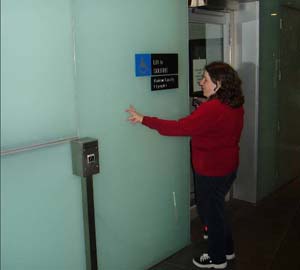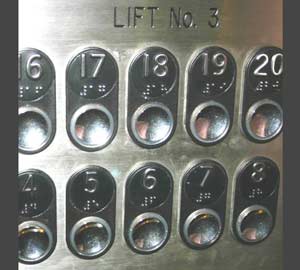Extract from the Human Rights Commission website: © Australian Human Rights Commission
ISSUE 11:
Lift call buttons
Importance of the feature
Lift call buttons if located and designed in accordance with the regulations will assist many people with disabilities to confidently use a lift. Often the call buttons are difficult or impossible to use due to their size, location or lack of clear raised tactual information.
If call buttons are placed too close to a corner, this restricts people who use a wheelchair from accessing the buttons. Placement of external call buttons within a reasonable distance from the lift will assist in their being found by people who are blind or vision impaired.
In many situations the raised tactile numbers and Braille information is not available or inadequately designed.
Location of the call buttons and their style is vital if they are to be easily identified and read, particularly by people who are blind or vision impaired. Location of call buttons is assisted by good illumination and use of the luminance contrast criteria.
Code requirements
The Building Code of Australia (BCA) addresses lifts in D3.3(a)(iii) & E3.6 where it refers to and requires compliance with the criteria to be met for lifts for people with disabilities and AS1735.12.
AS 1735.12 specifies technical details such as dimensioning, and design criteria.

Photo 1
Photo 1 shows good position for control buttons
Achieving best results
To be effective lift call buttons must be within the design criteria set out in AS1735.12.
This is achieved by ensuring:
- Mounted within the required height range.
- Use of raised tactile and Braille on or adjacent to call buttons to ensure easy identification.
- Correct use of luminance contrast.
- Good provision of lighting.
Note: The Commission’s view is that raised tactile and Braille information is most accessible if placed adjacent to or above the buttons and not on them as there is a probability of someone engaging a button when trying to read it by touch.
Common problems and misinterpretations
1. Location of call buttons.

Photo 2

Photo 3

Photo 4

Photo 5
Photos 2 and 3 show the call buttons for the same lift at different locations on each floor and too far away from the lift, which makes them difficult to locate for a person who is blind or vision impaired.
Photos 4 and 5 show lifts that have the call buttons within the minimum 500mm from an internal corner, which is difficult and in some instances impossible for people who use a wheelchair to access. Photo 4 is a recently refurbished lift.

Photo 6

Photo 7

Photo 8
The lifts in photos 6, 7 and 8 have used call buttons that meet the requirements with location, luminance contrast application, lighting and raised tactile and Braille consistently placed adjacent to each button.

